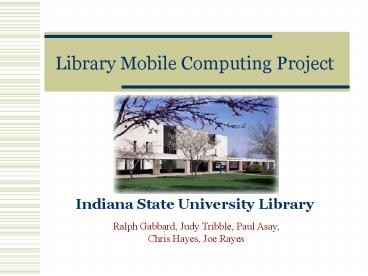Library Mobile Computing Project - PowerPoint PPT Presentation
Title:
Library Mobile Computing Project
Description:
Library Mobile Computing Project Indiana State University Library Ralph Gabbard, Judy Tribble, Paul Asay, Chris Hayes, Joe Rayes ISU Background Comprehensive ... – PowerPoint PPT presentation
Number of Views:107
Avg rating:3.0/5.0
Title: Library Mobile Computing Project
1
Library Mobile Computing Project
- Indiana State University Library
Ralph Gabbard, Judy Tribble, Paul Asay, Chris
Hayes, Joe Rayes
2
ISU Background
- Comprehensive university
- 11,000 students
- Students from rural areas and lower socioeconomic
backgrounds
3
ISU Library
- Current building opened in 1973.
- Over 1 million volumes on five floors.
- Graduate and faculty carrels are not currently
networked. - Over 60 databases available through the library
home page.
4
Inspiration Cornells Live From the Stacks
- First, mobile document scanners.
- Second, mobile computers.
5
The Mobile Project Plan
- Mobile Project Plan.
- Planned workstation syncing prototype.
- Investigate wireless LANs.
6
Project Plan Goals Objectives
- Team approach.
- The goals.
- Problems encountered.
- Networking.
- Security.
- Usability.
- Costs.
7
Scenario One
- A patron enters the library. At the main desk,
s/he checks out a hand-held scanner. The patron
takes the scanner into the stacks to scan text
and graphics from books, journals, and other
printed materials in the library. - Before leaving the library, the patron can print
or transfer the scanned files to the his/her disk
or laptop computer for use in electronic
documents.
8
Scenario One, Handheld Scanners
- HP CapShare 920 mobile e-copier.
- Checkout procedures.
- Downloads via infrared port.
- Bundled Pagis pro software handles text
conversion. - Required a Download workstation.
9
Mobile E-copier Details
- While fairly simple to operate, it did require
advance software, and infrared capable
transmission.
10
Lessons Learned
- Usability testing and prototyping
- Training
- Problems
11
Scenario One Costs
- HP Capshare Scanner Costs 4 _at_ 279.00 total
1116.00. - Extended Systems Infrared USB Adapters 4 _at_
54.00 total 216.00. - Watchdog cards 4 _at_ 85.00 340.00.
12
Evolving Workstations
- Library workstations currently have only one
look. - Download workstation addition.
- Later add an express kiosk station.
- Switched workstation security to Watchdog
internal cards.
13
Scenario Two
- A patron enters the library and using a mobile
computing device, the patron - searches the on-line catalog,
- interacts with others on the network
- takes and records notes
- Locates books and other materials
14
Scenario Two, Parts 1-6
- Parts 1 and 2 Install wireless network
- Part 1 wire faculty carrels
- Part 2 wire rest of building
- Part 3 Test handhelds and PC cards
- Part 4 Set up mobile web site
- Part 5 Install reference chat room
- Part 6 Develop book locator software
15
Setting up the network
- Wireless network access in all faculty carrels.
- High potential for mobile device usage.
- Lower cost than wiring 54 carrels.
16
Wireless Network Infrastructure
- Mobile computing required an effective wireless
network. - We settled on a combination of 802.11b components
from Cisco and Compaq. - Both comply with the WI-FI standard.
17
Wireless LAN Site Survey
18
Carrel Wireless Costs
- Total hardware including 7 Cisco access points,
and 10 wireless cards 8,123.00. - Total installation costs including wiring, and
power 2,100.00. - We conducted the site survey ourselves to
determine the number and location of access
points.
19
Setting up the Network Part Two
- Extend the wireless network into every public
area of the library.
20
Wireless LAN Site Survey
21
Rest of Library Wireless Costs
- Total hardware including 17 Cisco access points,
8 Compaq PCI/software access points cost
18,042.00. - Total installation costs including wiring, and
power 5,100.00.
22
Choosing Handheld OS
- Several choices of handheld computers, but few
that are network capable. - Limited choices available Palm, PocketPCs,
Psion, and Win CE handheld PCs. - Garfinkel, Simson. The net effect handheld
heaven. TECHNOLOGY REVIEW, January/February 2001
23
Handheld Specifics Developmental Phase
- Compaq iPAQ 3650 PDA.
- Includes expansion pack for PC cards.
- Compaq WL100 wireless network card.
- Syncs via USB cradle to download workstation.
24
Handheld Costs Developmental Phase
- Compaq iPAQ handheld with wireless cards and
expansion packs costs 2 _at_ 720.00 14200.00.
25
Mobile Web Presence
- Screen capability on mobile devices may force you
to rethink your web presence. - Potential use of a WAP server.
26
Scenario Two Part4 http//mobile.indstate.e
du
27
Scenario Two, Part 5 Reference Chat
- While in the stacks, the student can ask a
question of a staff member via chat software. - Used chat software which could be accessed from
more than one workstation. - Restricted by IP authorization.
28
Scenario Two Part 6 Book Locator
- While in the stacks the user can search the
catalog for a book, find a call number, then use
Book Locator to determine which floor and shelf
the book occupies.
29
Considerations for the Near Future
- Handhelds, notebooks, tablet size pcs, and web
enabled cell phones.
30
Future Directions
- E-pop.
- Changing workstations.
- Providing students with a library workspace.
- Support the rapidly changing mobile environment.
31
Conclusions
- Mobile computing in the library is feasible and
may serve users better than wired networking in
specific cases.
32
Conclusions
- The library is a good place to prototype mobile
computing on campus.































